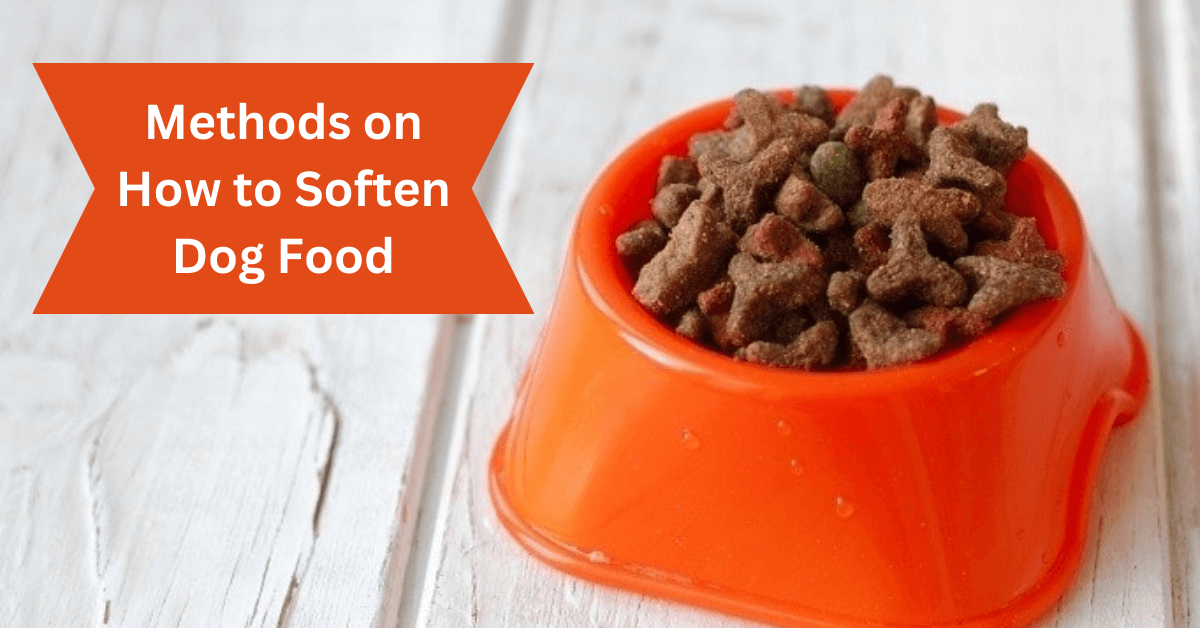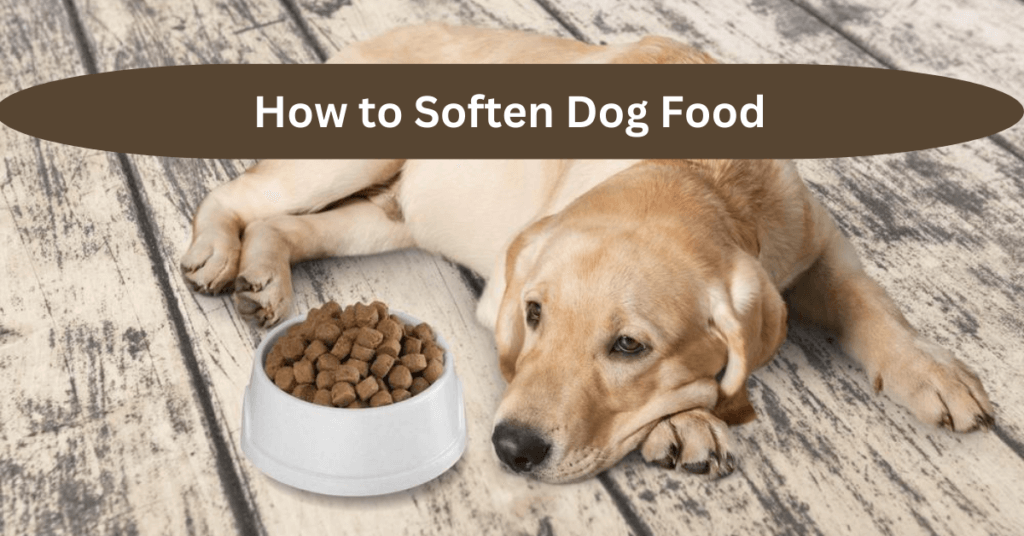How to Soften Dog Food
Understanding how to soften dog food is fundamental for owners who want to improve their animals’ mealtime experience. This knowledge can significantly benefit dogs of all ages and health conditions, allowing owners to cater to specific needs, such as puppies with developing teeth, elderly dogs struggling with chewing, or those recovering from dental procedures.
Softening dog food involves various methods, like using warm water, adding broth, mixing with wet food, or even blending dry kibble into a more manageable consistency. Each approach aims to make the food more accessible to chew and digest, promoting better nutrient absorption and overall health.
Softened food helps puppies transition from mother’s milk to solid food, easing the strain on their growing teeth. Elderly canines with potential dental problems or reduced jaw strength find softened food more accessible and enjoyable. Even dogs with medical conditions benefit from softened food, as it reduces the risk of choking and aids in digestion.
In this blog, I will discuss the benefits of different methods of softening dog food and provide practical tips for choosing the right approach for your furry companion’s needs. Mastering how to soften dog food ensures your dog gets the nourishment it needs comfortably and safely.
Methods on How to Soften Dog Food

Dog food can be softened through various methods, each catering to dogs’ preferences and dietary needs. Here’s a detailed guide on the most effective methods:
-
Using Warm Water
Adding warm water to dry kibble is one of the simplest and most common methods to soften dog food.
- Step-by-step guide on adding warm water to dry kibble:
- To begin, determine how much dry material is necessary kibble for your dog’s meal.
- Heat water until it’s warm but not boiling.
- Pour the warm water over the dry kibble in a bowl, using enough water to cover it completely.
- Recommended water-to-food ratio:
- Generally speaking, one should utilize roughly 1/2 to 1 cup of water per cup of dry kibble, depending on your dog’s preference for softer or firmer food.
- Tips for optimal soaking time:
- Let the kibble soak in the warm water for 10-15 minutes. This allows the kibble to absorb the water and soften to a palatable consistency.
-
Adding Broth
Using broth, such as chicken, beef, or vegetable, adds flavor and nutrients to soften dog food.
- Types of broth suitable for dogs:
- Choose low-sodium and preferably homemade broth without onions or garlic, which can harm dogs.
- Instructions on how to use broth to soften dog food:
- Heat the broth until warm.
- Pour the warm broth over the dry kibble, using enough to cover the kibble.
- Nutritional benefits of using broth:
- Broth improves the flavor and adds moisture to the dog food, making it more appealing to picky eaters.
- It also provides extra nutrients like protein and minerals, depending on the type of broth used.
-
Mixing with Wet Food
Combining dry kibble with wet canned food is another effective way to soften dog food and enhance its flavor.
- How to combine dry kibble with wet canned food:
- Measure the appropriate amount of dry kibble and wet food according to your dog’s dietary needs.
- Mix the two thoroughly in a bowl until well combined.
- Proportions and mixing techniques:
- Adjust the dry kibble to wet food ratio based on your dog’s preference and nutritional requirements.
- Ensure thorough mixing to distribute flavors and textures evenly.
- Advantages of this method:
- Wet food adds moisture and flavor, enticing the meal for picky eaters.
- It provides a balanced diet by combining the nutritional benefits of both dry and wet foods.
-
Using a Blender
Blending dry kibble into a finer consistency can benefit dogs who prefer smoother textures or have difficulty chewing.
- How to blend dry kibble into a softer consistency:
- Place the desired amount of dry kibble into a blender or food processor.
- Add a small amount of water or broth to the blender to help soften the kibble.
- Blend until the kibble reaches a smooth, paste-like consistency.
- Adding liquids (water, broth) during blending:
- Gradually add liquid while blending to achieve the desired texture. Be cautious not to add too much liquid, which may make the mixture runny.
- Suitable blenders and food processors:
- Use a superior food processor or blender to grind the kibble without leaving large chunks.
-
Microwaving Dog Food
Microwaving dog food is quick and effective for softening, but caution must be exercised to avoid overheating and nutrient loss.
- Safe microwaving practices:
- Place the desired dry kibble, water, or broth in a microwave-safe bowl.
- Microwave briefly, stirring between each one to ensure even heating.
- Step-by-step instructions:
- Start on medium power for 20-30 seconds, then check and stir.
- Continue microwaving in 10-15-second intervals until the food reaches a softened consistency.
- Precautions to avoid overheating and nutrient loss:
- Avoid microwaving for too long to prevent overheating, which can destroy nutrients and alter the taste and texture of the food.
- Stirring between intervals helps distribute heat evenly and prevents hot spots that could burn your dog’s mouth.
By choosing the right method to soften dog food based on your dog’s preferences and health needs, you can ensure your dog enjoys its meals comfortably and receives the nutrition for its well-being.
Understanding the Need to Soften Dog Food

Why soften dog food?
Softening dog food is essential for several reasons, particularly for dogs facing specific challenges, such as puppies, seniors, those with dental issues, or picky eaters.
Various Scenarios Where Softened Dog Food is Beneficial:
- Puppies: Puppies have developing teeth and jaws not fully equipped to handle hard, dry kibble. Softened dog food helps them transition from nursing to solid food more comfortably. It reduces the risk of choking and makes it easier for them to chew and digest their meals.
- Senior Dogs: Older dogs often experience dental problems like missing teeth, gum disease, or weaker jaws. Softened dog food is gentler on their mouths, making it less painful to eat. It ensures they can still receive necessary nutrition without struggling with hard, crunchy foods that may cause discomfort or be difficult to chew.
- Dogs with Dental Problems: Softened dog food benefits dogs suffering from dental issues such as broken or sensitive teeth, gingivitis, or oral surgeries. It minimizes the pressure on their teeth and gums during chewing, reducing pain and inflammation accompanying these conditions.
- Picky Eaters: Some dogs are simply picky about their food’s texture or taste. Softening dog food can make it more appealing and easier to consume, encouraging them to eat a balanced diet without resistance.
Health Benefits of Softened Dog Food:
- Ease of Digestion: Softened dog food is easier for dogs to digest because it starts breaking down before reaching the stomach. This reduces the strain on their digestive systems, which is especially advantageous for dogs with sensitive stomachs or digestive disorders.
- Prevention of Choking Hazards: Dogs, especially small breeds or those prone to gulping their food, are at risk of choking on large, dry kibble pieces. Softened dog food reduces this risk by breaking it down into smaller, softer particles that are safer to swallow.
- Enhanced Nutrient Absorption: Softened dog food allows for quicker and more efficient nutrient absorption by the dog’s body. The softened texture ensures that essential vitamins, minerals, and proteins are more readily available for absorption in the digestive tract, promoting overall health and vitality.
Understanding these benefits underscores the importance of effectively softening dog food. By choosing the right method and consistency, customized to your dog’s unique requirements and medical circumstances, you can ensure your dog enjoys mealtime comfortably and maintains optimal health throughout its life stages.
Tips for Softening Dog Food

Softening dog food effectively requires attention to liquid choices, temperature, and consistency. Here are some essential tips:
Choosing the Right Liquid
- Best liquids to use (water, broth, milk alternatives):
- Water is the most common and safest option for softening dog food.
- Broth (chicken, beef, or vegetable) adds flavor and nutrients.
- Milk alternatives like lactose-free milk or goat’s milk can also be used sparingly for added taste.
- Liquids to avoid (cow’s milk, sugary drinks):
- Avoid cow’s milk, as many dogs are lactose intolerant and may have digestive issues.
- Sugary drinks or flavored liquids should be avoided as they can lead to weight gain and dental problems.
Monitoring Temperature
- Importance of using lukewarm liquids:
- Lukewarm liquids are ideal as they help soften the food without altering its nutritional value.
- Extreme temperatures can destroy nutrients and may be uncomfortable for your dog.
- How to test the temperature:
- Before serving, test the temperature by touching a small amount of the softened food to the inside of your wrist.
- It should feel comfortably warm, similar to baby food, and not hot.
Adjusting Consistency
- How to achieve the desired softness:
- Add a small amount of liquid and gradually increase until the desired softness is achieved.
- Stir well and let the food sit for a few minutes to absorb the liquid.
- Adjusting the amount of liquid based on the dog’s preference:
- Some dogs prefer their food to be softer or firmer. Pay attention to how your dog responds and adjust the amount of liquid accordingly.
- For picky eaters, experimenting with different textures can help encourage them to eat.
Following these tips ensures that your dog’s meals are softened to a palatable consistency while maintaining nutritional integrity. Adjusting liquid types and amounts based on your dog’s needs and preferences will help make mealtime enjoyable and beneficial for their health.
Special Considerations
Depending on your dog’s age or health condition, softening dog food may require special attention. Here are key considerations:
Softening Dog Food for Puppies
- Special needs of puppies and appropriate methods:
- Puppies’ jaws and teeth are still growing and are quite sensitive. Softening their food helps them transition from milk to solid food more easily.
- Use methods like adding warm water or mixing with wet food to create a softer texture that is gentle on their teeth and easier to chew.
Softening Dog Food for Senior Dogs
- Addressing common senior dog issues (dental, digestive):
- Senior dogs often face dental problems such as missing teeth, gum disease, or reduced jaw strength. Softened dog food can alleviate discomfort during eating.
- Choose methods like broth or blending food to make it easier for them to chew and digest.
Softening Dog Food for Dogs with Medical Conditions
- Customizing softness for specific health conditions (e.g., kidney issues, dental surgeries):
- Dogs with medical conditions may require customized diets that are softer and easier to digest.
- For example, dogs with kidney issues may need low-protein diets that can be softened with water or broth.
- After dental surgeries, dogs may need very soft food that can be prepared by blending or microwaving to a gentle consistency.
Understanding these considerations ensures that you can tailor your dog’s diet to its specific needs, promoting its health and well-being through properly softened food that meets its nutritional requirements.
Frequently Asked Questions (FAQs)
How long can softened dog food be stored?
Softened dog food should be stored in the refrigerator within 24-48 hours to prevent bacterial growth and maintain freshness.
Can all dog foods be softened?
Warm water or broth can soften most dry and semi-moist dog foods. However, canned wet foods are already soft and do not require additional softening.
Is it okay to leave softened dog food at room temperature for an extended period of time?
No, leaving softened dog food out at room temperature for an extended period is not recommended. This can promote bacterial growth and spoilage. Always refrigerate leftover softened dog food promptly to maintain its safety and quality.
Conclusion
In conclusion, understanding how to soften dog food is crucial for ensuring your dog’s mealtime satisfaction and health. By softening dog food, you can:
- Summarize the key points: Softening dog food helps puppies with developing teeth, seniors with dental issues, and dogs with medical conditions eat comfortably.
- Knowing how to soften dog food has many benefits: It improves digestion, reduces choking hazards, and enhances nutrient absorption, promoting overall well-being.
- Encourage readers to try different methods: Experiment with adding warm water, broth, mixing with wet food, blending, or microwaving to discover what your dog prefers. Finding the right method can make mealtime enjoyable and nutritious for your furry friend.

